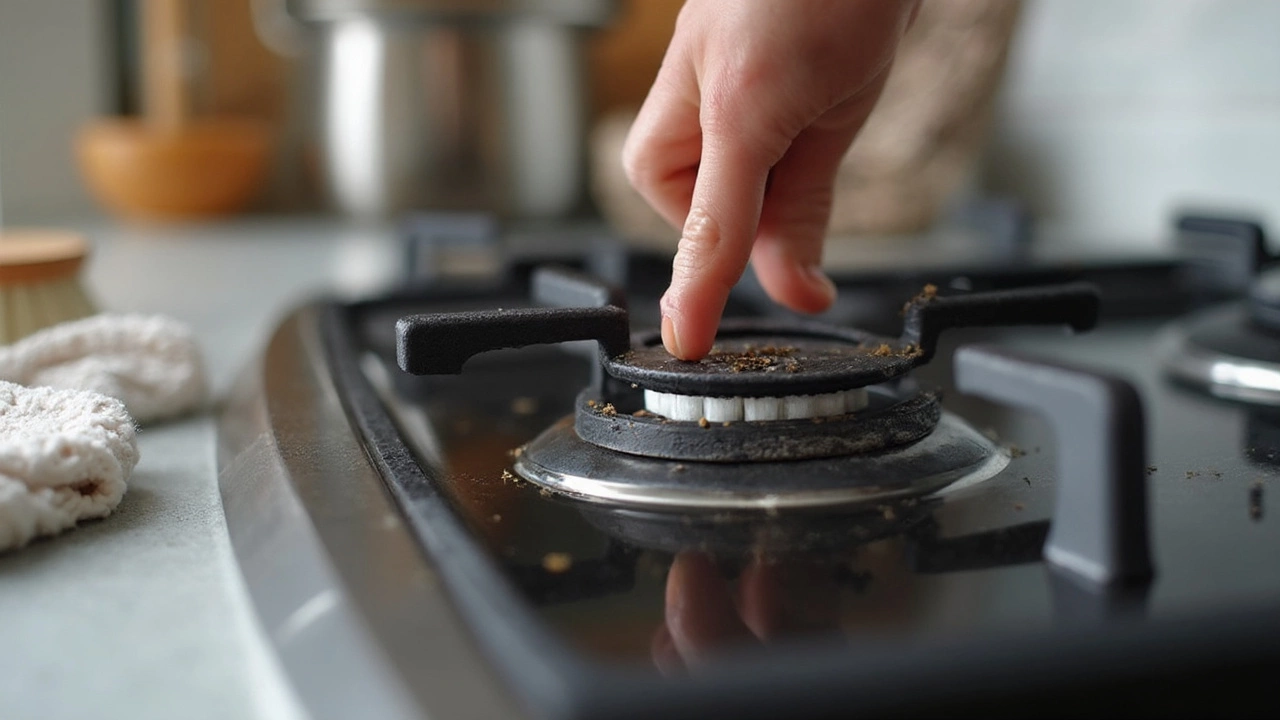Ever turned the knob on your gas hob and ended up staring at a stubborn burner that just won’t light? It happens more often than you might think. Most of the time, gas hobs stop working because of really basic stuff—stuff you can spot and sometimes even fix yourself. We’re talking about things like grime clogging up tiny holes in the burner, or that little click-click-click from the ignition just not firing up. Yes, regular cleaning matters more than you’d guess.
A classic reason for a dead hob is a blocked jet. Even the thinnest layer of grease or boiled-over soup can leave a burner sputtering or out cold. Other classic hiccups? Faulty ignition switches, loose wiring, or even a tripped safety device. If you hear the igniter sparking but nothing catches, you probably have a gas flow issue. No spark at all? That’s usually electrical, not gas.
If your kitchen constantly smells faintly of gas, don’t ignore it—gas leaks are no joke. Stop using the hob, air the place out, and get it checked by a pro. For smaller problems, though, you might only need a toothpick, a paperclip, or even a quick wipe-down to get things hot again.
- What Usually Goes Wrong with Gas Hobs
- Simple Troubleshooting Steps
- Parts That Often Need Replacing
- When to Call a Pro
What Usually Goes Wrong with Gas Hobs
You wouldn’t believe how often people blame the whole hob when just a tiny part is acting up. Nine times out of ten, it’s the little things that mess up how a gas hob works, not the whole unit suddenly breaking down. Here’s what usually goes wrong.
- gas hob repair is often needed because of blocked burners. Food spills over, grease collects, or just the usual dirt builds up. These blockages stop gas from flowing smoothly, and the flame either gets weak or disappears completely.
- Ignition problems are super common too. That clicking sound you hear when turning the knob? It comes from the igniter. If you don’t hear it or it sounds odd, the spark could be missing or too weak to light the gas. Sometimes the igniter just gets dirty; other times, it wears out.
- Loose knobs or faulty control valves can also mess things up. If a knob feels wobbly or doesn’t turn the burner on and off reliably, you might have a broken internal part or a busted valve. This not only stops things from working but can also be unsafe.
- Electrical faults sneak up on people. Gas hobs need a small electric current for the igniter and controls. If the wiring inside gets loose, damaged, or wet (think of cleaning spills), then things just stop working.
- Finally, gas pressure issues make a difference. If the flames look weak no matter what you try, or if the burners hiss or burn yellow, the gas supply could be the problem. Sometimes the regulator at the gas bottle or pipe is faulty or clogged.
Knowing what goes wrong helps you spot problems before they get worse. It's not always a big deal—often, it’s just a grubby burner or a loose connection. The trick is figuring out which of these simple issues is holding things up in your kitchen.
Simple Troubleshooting Steps
Before calling the repair guy or spending money on new parts, try these simple things. Nine times out of ten, gas hob issues are down to something small and fixable right at home.
Start by making sure the hob is plugged in (if you’ve got electric ignition). You’d be surprised how often plugs get knocked loose during a kitchen clean or by shuffling appliances around.
- Check for Obvious Blockages: Remove the burner cap and look for food bits, grease, or any dirt. Use a toothpick or a pin to gently clean out the little holes in the burner. Even a thin coating can cause trouble.
- Test the Ignition: Listen for the clicking sound. If you hear it but there’s no flame, chances are, gas isn’t flowing. If there’s no click at all, you might have a dud ignition switch or the power supply’s out.
- Look for Loose Wires: Unplug the hob and check underneath for any disconnected or loose wires, especially if you’ve recently moved the appliance or had work done nearby.
- Reset the Safety Device: Some modern hobs have a safety lock or a thermocouple. If it’s tripped, you’ll need to reset it—check the user manual for your specific model.
- Check Gas Supply: Make sure the gas valve is open. If you’ve got bottled gas, check if you’re out; if you’re on mains, make sure nothing’s been shut off for maintenance.
If you still have no luck, double-check against the stats below. According to the UK Household Appliance Survey (2023), around 57% of gas hob faults come down to blocked burners or ignition issues you can spot with the naked eye. Only about 15% require replacement parts or a pro repair.
| Problem | % of Cases Found (UK 2023) |
|---|---|
| Blocked Burner | 34% |
| Ignition Fault | 23% |
| Electrical/Wiring Issue | 18% |
| Gas Supply Problem | 10% |
| Other | 15% |
If you’re ever in doubt about anything more serious—like leaks or burned wiring—don’t risk it. Gas is dangerous stuff. As appliance expert Danielle Smith says:
“If you smell gas or see scorch marks around the hob, shut off the supply and call a qualified gas engineer. Don’t try to fix it yourself.”
But, for the basics, these quick steps will have your gas hob repair skills looking solid in no time. No toolbox full of fancy gear required—sometimes, just a steady hand and a bit of common sense does the trick.

Parts That Often Need Replacing
When your gas hob decides to go on strike, usually it’s because one of a few key parts has given up. Most issues boil down to stuff that wears out with regular cooking. Here’s where most people run into trouble:
- Ignition switches: These little buttons or knobs are the heroes of that familiar “click-click” sound. If your hob isn’t sparking, the ignition switch is often the culprit. Sometimes grime causes them to stick, but after years of use, they can just wear down.
- Spark electrodes: These sit next to the burner and actually create the spark. If the tip is chipped, rusty, or covered in gunk, your gas hob won’t light, no matter how many times you try.
- Burner caps and rings: Constant heating and cooling can warp these. Even a tiny bend or dent can mess up the flame or stop ignition. Good news—they’re easy and pretty cheap to swap out.
- Thermocouples: This is your safety switch. If it’s faulty, the gas supply gets cut off, even if everything else seems fine. It’s super important; a dodgy thermocouple isn’t something you want to ignore.
- Control knobs: Plastic and heat are a bad mix over time. Cracked or loose knobs can mess up gas flow or make the hob hard to turn on or off. If you notice a knob feels wobbly or looks damaged, it’s probably time for a new one.
Here’s a quick look at how often these parts typically need changing:
| Part | Average Lifespan | Signs It Needs Replacing |
|---|---|---|
| Ignition Switch | 3-5 years | No spark, sticking, or unresponsive button |
| Spark Electrode | 4-6 years | No ignition, visible corrosion, weak spark |
| Burner Cap/Ring | 5-8 years | Uneven flame, visible warping, burnt spots |
| Thermocouple | 6-10 years | Burner won’t stay lit, frequent shutdowns |
| Control Knob | 3-7 years | Cracking, wobbling, difficulty turning |
If you stay on top of replacing these as soon as they get dodgy, your hob will usually bounce right back without much hassle. By the way, the most searched problem with gas hob repair is often tied to ignition failure, so always start your checks there.
When to Call a Pro
Sometimes, no amount of googling or elbow grease will get your gas hob working again. There are certain jobs that should only be tackled by someone with the right training and tools. If you run into anything electrical or anything that smells like a gas leak, stop right away—messing with these can be straight-up dangerous.
- If you smell gas around your hob, switch it off, open windows, and call a certified engineer. Never try fixing a gas leak yourself.
- Burners that keep clicking but don't ignite, even after cleaning and checking connections, could mean you have a broken ignition module or an issue with the spark generator—both best left to the pros.
- If you’ve replaced parts like knobs or igniters and the problem still sticks around, there could be deeper electrical faults at play.
- Signs of melted wires, scorched areas, snapped valves, or a dead control board all call for professional help. Don’t risk starting a fire or a shocking accident at home.
- If your hob is still under warranty, trying to fix complex parts by yourself can void that warranty. Always check first.
Wondering how risky it really is? Each year in the UK, the Gas Safe Register reports over 1,200 incidents where illegal or DIY work led to dangerous gas leaks or fires.
| Issue | DIY Fix? | Call a Pro? |
|---|---|---|
| Blocked or dirty burners | Yes | No |
| Faulty ignition switch | Maybe | Yes if persists |
| Gas leak detected | No | Yes |
| Wiring or electrical faults | No | Yes |
| Replacement of control board | No | Yes |
If your fixes aren’t working or things get worse, don’t keep tinkering. Turn everything off and call a registered gas engineer. Your gas hob repair is one area where it’s better to play it safe than sorry.


